-
Paper Information
- Paper Submission
-
Journal Information
- About This Journal
- Editorial Board
- Current Issue
- Archive
- Author Guidelines
- Contact Us
Applied Mathematics
p-ISSN: 2163-1409 e-ISSN: 2163-1425
2012; 2(1): 8-16
doi:10.5923/j.am.20120201.02
On the Minimum ABC Index of Chemical Trees
Tzvetalin S. Vassilev, Laura J. Huntington
Department of Computer Science and Mathematics, Nipissing University, North Bay, Ontario, P1B 8L7, Canada
Correspondence to: Tzvetalin S. Vassilev, Department of Computer Science and Mathematics, Nipissing University, North Bay, Ontario, P1B 8L7, Canada.
| Email: |  |
Copyright © 2012 Scientific & Academic Publishing. All Rights Reserved.
The Atom Bond Connectivity index, also known as ABC index was defined by Estrada[4] with relation to the energy of formation of alkanes. It was quickly recognized that this index reflects important structural properties of graphs in general. The ABC index was extensively studied in the last three years, from the point of view of chemical graph theory[5,6], and in general graphs[1]. It was also compared to other structural indices of graphs[2]. Das derives multiple results with implications to the minimum/maximum ABC index on graphs. With relation to trees, it is known that among all the trees of the same number of vertices, the maximum ABC index is attained for the star graph. However, it is not known which tree(s) minimize(s) the ABC index. The problem seems to be hard. It is partially addressed in many sources[5,1,6], but remains open. In this paper we further investigate the trees that minimize the ABC index. Our investigations are limited to chemical trees, i.e. trees in which the maximum vertex degree is 4. The chemical trees were introduced to reflect the structure of the carbon chains and the molecules based on them. Our approach is algorithmic. We identify certain types of edges (chemical bonds) that are important and occur frequently in chemical trees. Further, we study how the removal of a certain edge, the introduction of certain edge or the contraction of certain edge affects the ABC-index of the tree. We pay particular attention to the examples of minimal ABC index chemical trees provided by Dimitrov[3].
Keywords: Chemical graph theory, Structural indices of graphs, Chemical trees
Cite this paper: Tzvetalin S. Vassilev, Laura J. Huntington, On the Minimum ABC Index of Chemical Trees, Applied Mathematics, Vol. 2 No. 1, 2012, pp. 8-16. doi: 10.5923/j.am.20120201.02.
Article Outline
1. Introduction
- This paper will discuss the Atom-bond connectivity index, its origins, its uses and its applications. The central topics of discussion for this paper will include: an investigation of the Furtula examples (provided through a personal communication), an exploration of the structure of the maximal and minimal chemical trees for the ABC index, and the contribution of certain types of vertices and edges to the ABC index of the graph as a whole. It will also consider graphs from a specific class Γ (to be defined later) and their ABC indices.
2. Formulation and History of the ABC Index
- The atom-bond connectivity index, (ABC index), was first proposed by Ernesto Estrada in 1998. Estrada is a Cuban mathematician born in 1966. He is currently a professor and chair in Complexity Sciences at the University of Strathclyde in Glasgow, Scotland. The ABC index is a new topological index that has proven to be a valuable predictive index in the study of the heat of formation in alkanes[1]. For those who may not be familiar with alkanes, these are any of the series of saturated hydrocarbons having the general formula CnH2n+2, including methane, ethane and propane.The ABC index comes from the connectivity index, χ, which was introduced in 1975 by Milan Randić[1]; however, the connectivity index deals with molecular branching. Estrada wanted to take into account the many physico- chemical properties that are not dependent on branching; thus, the ABC index was born.
2.1. Formulation
- The ABC index is defined as follows:
 where the summation goes over all the edges of G, du and dv are the degrees of the terminal vertices u and v of edge uv and E(G) is the set of edges of G with cardinality m = |E(G)|.
where the summation goes over all the edges of G, du and dv are the degrees of the terminal vertices u and v of edge uv and E(G) is the set of edges of G with cardinality m = |E(G)|.2.2. Example
- Let G be the following graph
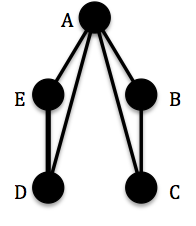
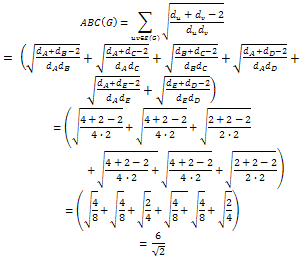
2.3. Chemical Trees and Some Examples
- A tree in graph theory is any connected graph without a cycle or, in other words, an undirected graph in which any two vertices are only connected by exactly one simple path. Chemical trees are trees that have no vertex with degree greater than 4.Examples of chemical trees:Chains:
 Trees:
Trees: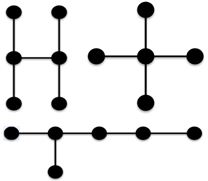 The following are not chemical trees:Graphs of vertex degree greater than 4 and graphs with cycles:
The following are not chemical trees:Graphs of vertex degree greater than 4 and graphs with cycles: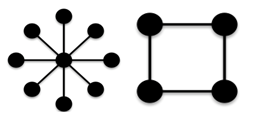
3. The ABC Index of Chemical Trees
- This section of the paper will focus on the properties and applications of the ABC index on chemical trees. First, there will be an exploration of the contribution of specific types of edges to the ABC Index of a chemical tree and then a table will be developed to describe the contribution of specific edges more efficiently.
3.1. Contribution of Specific Edges
- Contribution of a pendant edge (an edge of a graph is said to be a pendant edge if one of its vertices is of degree 1):Let d equal the degree of the terminal vertex of a pendant edge uv that is not one.Let e be the pendant vertex (e=1).Then the contribution of the edge uv to the graph is given by:
 Contribution of an edge uv whose terminal vertices are of degree d and 2:
Contribution of an edge uv whose terminal vertices are of degree d and 2: Contribution of an edge uv whose terminal vertices are of degree 1 and 3:
Contribution of an edge uv whose terminal vertices are of degree 1 and 3: Contribution of an edge uv whose terminal vertices are of degree 1 and 4:
Contribution of an edge uv whose terminal vertices are of degree 1 and 4: Contribution of an edge uv whose terminal vertices are of degree d and 3:
Contribution of an edge uv whose terminal vertices are of degree d and 3: Contribution of an edge uvwhose terminal vertices are of degree d and 4:
Contribution of an edge uvwhose terminal vertices are of degree d and 4:
3.2. Table of Edge Contributions
- Thus one can develop the following table in order to increase the ease with which one can calculate the ABC index of a graph G.
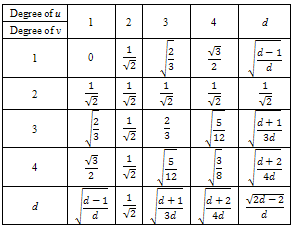
4. Chemical Trees of Minimal ABC Index
- In this section, we will establish some notation to be used throughout the rest of the paper. There will also be an exploration of the notion of chemical trees of minimal ABC indices including a discussion and examination of the examples provided by Boris Furtula in a personal communication. (Furtula will be discussed in greater detail in the section 4.3).
4.1. Notation
- In this section, it is necessary to establish notation for certain types of edges. Let an
 edge be an edge with a terminal vertex of degree
edge be an edge with a terminal vertex of degree  and the other terminal vertex of degree
and the other terminal vertex of degree  . For example, a 3-4 edge is an edge between vertices of degree 3 and 4 respectively. Also let
. For example, a 3-4 edge is an edge between vertices of degree 3 and 4 respectively. Also let  denote a transformation of an
denote a transformation of an  edge to a
edge to a  edge. For example,
edge. For example,  means that a 2-2 edge was transformed into a 2-1 edge by adding or removing certain vertices and edges as specified in each unique case presented.
means that a 2-2 edge was transformed into a 2-1 edge by adding or removing certain vertices and edges as specified in each unique case presented.4.2. Finding Chemical Trees of Minimal ABC Index
- First, let n be the number of vertices in the chemical tree G. At first glance, the obvious choice for the shape of a chemical tree of minimal ABC index would seem to be the chain. In fact, this is true for chemical trees with n≤6.n=2

 This is the only possible arrangement for a chemical tree with 2 vertices.n=3
This is the only possible arrangement for a chemical tree with 2 vertices.n=3
 The chain is once again the only option.n=4
The chain is once again the only option.n=4

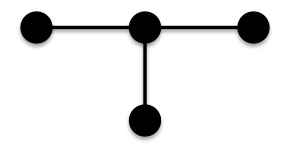
 n=5
n=5

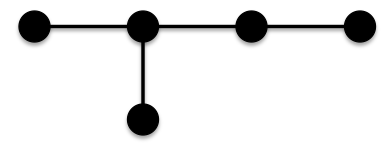

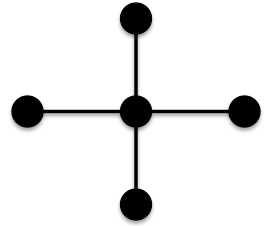
 n=6
n=6

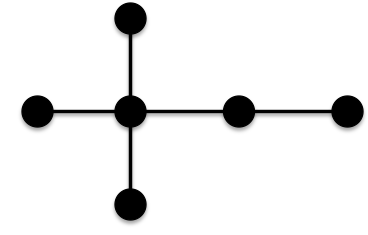

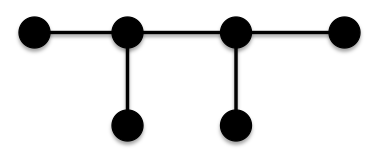

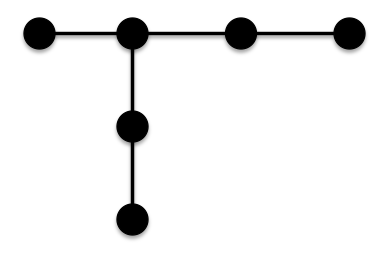
 Thus for n≤6, the chain has the minimal ABC index.
Thus for n≤6, the chain has the minimal ABC index.4.3. Boris Furtula and Chemical Tress with More than 6 Vertices
- Boris Furtula was born in 1978 in Kragujevac, Serbia. He is a professor in the Faculty of Science at Kragujevac University where he studied for all of his post-secondary education. Furtula is a leader in the study of chemical graph theory, known for his extensive research on the ABC Index.According to a personal communication with Furtula[3], there are two possible chemical trees with 7 vertices and minimal ABC indices.The first is the chain:

 And the second is the following tree:
And the second is the following tree: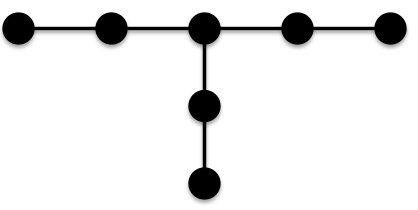 Note that all edges in this tree have at least one terminal vertex of order 2; this means that all the edges contribute the same amount to the ABC index
Note that all edges in this tree have at least one terminal vertex of order 2; this means that all the edges contribute the same amount to the ABC index  Thus, the ABC index of this formation is equal to the ABC index of the chain with 7 vertices.
Thus, the ABC index of this formation is equal to the ABC index of the chain with 7 vertices. Therefore, there are two different chemical trees with 7 vertices of minimal ABC index.Similarly for chemical trees with n=8, there are two different trees with 8 vertices of minimal ABC index.The chain:
Therefore, there are two different chemical trees with 7 vertices of minimal ABC index.Similarly for chemical trees with n=8, there are two different trees with 8 vertices of minimal ABC index.The chain: And another tree:
And another tree: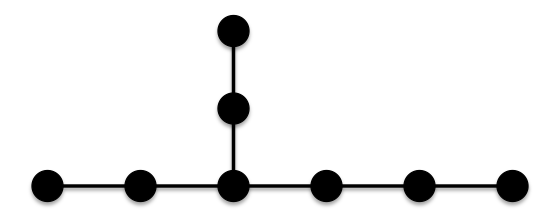 Note that similar to the tree of minimal ABC index for 7 vertices, all of this tree’s edges have at least one vertex of degree 2.For
Note that similar to the tree of minimal ABC index for 7 vertices, all of this tree’s edges have at least one vertex of degree 2.For  , there are 4 trees of minimal ABC index including the chain.
, there are 4 trees of minimal ABC index including the chain.
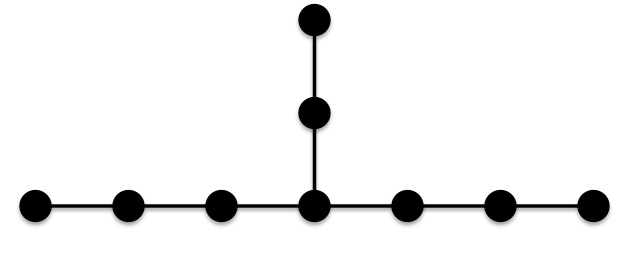
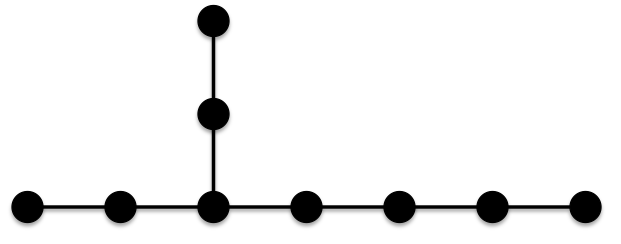
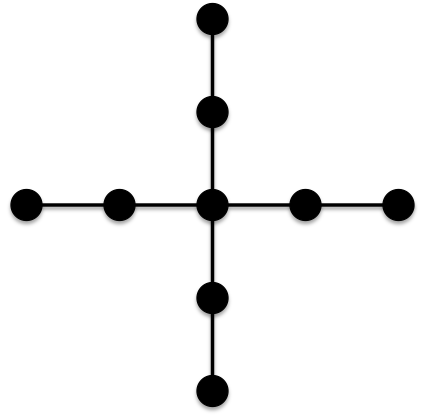 All four of these trees have edges which each have at least one terminal vertex of degree 2. Thus, all the edges in these trees contribute the same amount to the ABC index and since each of these graphs has 8 edges, all four of these trees have the same minimal ABC index as the chain of 9 vertices
All four of these trees have edges which each have at least one terminal vertex of degree 2. Thus, all the edges in these trees contribute the same amount to the ABC index and since each of these graphs has 8 edges, all four of these trees have the same minimal ABC index as the chain of 9 vertices 
4.4. Chemical Trees whose Chain is not among the Trees of Minimal ABC Index
- Thus far, the chain has been among the trees of minimal ABC index for 2≤n≤9; however, this is not the case for n≥10.Consider the chemical trees with n=10.It seems that from the previous examples that the minimal ABC index of trees with n=10 would be
 . This would be the case if all the edges of the tree had at least one terminal vertex of degree 2. But what if the tree could have an edge that would contribute less than one which has a vertex of degree 2 (namely less than
. This would be the case if all the edges of the tree had at least one terminal vertex of degree 2. But what if the tree could have an edge that would contribute less than one which has a vertex of degree 2 (namely less than  ).Consider the following tree with n=10:
).Consider the following tree with n=10: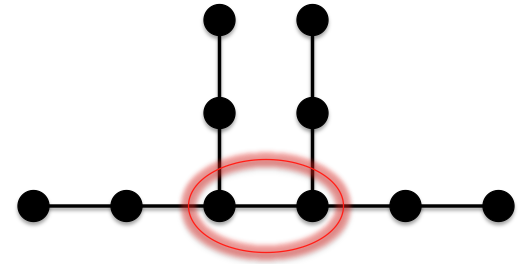 All of this tree’s edges have at least one vertex of degree 2 except for the one that is circled. This edge is between two vertices of degree 3. The contribution of the circled edge is as follows:
All of this tree’s edges have at least one vertex of degree 2 except for the one that is circled. This edge is between two vertices of degree 3. The contribution of the circled edge is as follows: Compare the contribution of this edge to an edge that has at least one of its terminal vertices of degree 2.
Compare the contribution of this edge to an edge that has at least one of its terminal vertices of degree 2. Thus, the indicated edge with vertices of degree 3 contributes less than one of the edges of a chain would and so the ABC index of this tree is less than the ABC index of a chain of 10 vertices. In fact, it is the only tree with 10 vertices of minimal ABC index according to Furtula.
Thus, the indicated edge with vertices of degree 3 contributes less than one of the edges of a chain would and so the ABC index of this tree is less than the ABC index of a chain of 10 vertices. In fact, it is the only tree with 10 vertices of minimal ABC index according to Furtula.5. Developing a Method for Determining the Chemical Tree of Minimal ABC Index
- Clearly then, a method for determining the chemical trees of minimal ABC index is to try to establish a combination of edges which contribute less than
 From the table above, these edges that contribute less than
From the table above, these edges that contribute less than  are the following: a 3-3 edge, 3-4 edge and a 4-4 edge. (Note that here we do not consider edges of degree greater than 4 because we are currently focusing on chemical trees).
are the following: a 3-3 edge, 3-4 edge and a 4-4 edge. (Note that here we do not consider edges of degree greater than 4 because we are currently focusing on chemical trees).5.1. Examining the Tree of Minimal ABC Index with 11 Vertices
- According to Furtula, the following tree is of minimal ABC index for 11 vertices:
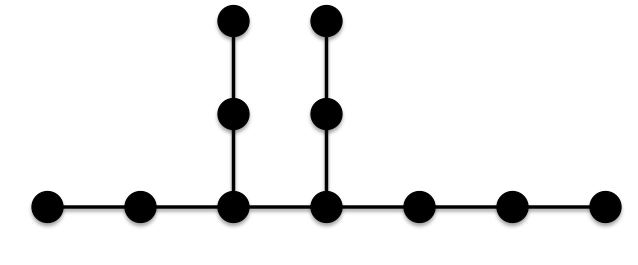
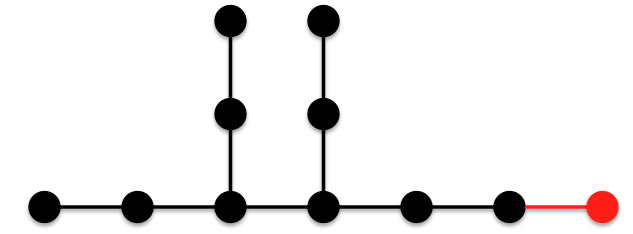 Note that this tree is very similar to the tree of minimal ABC index for 10 vertices; it simply has one more vertex and edge added to the horizontal chain.Let us explore the different ways one could form a tree with 11 vertices to try to determine why the new edge and vertex were placed where they were.
Note that this tree is very similar to the tree of minimal ABC index for 10 vertices; it simply has one more vertex and edge added to the horizontal chain.Let us explore the different ways one could form a tree with 11 vertices to try to determine why the new edge and vertex were placed where they were.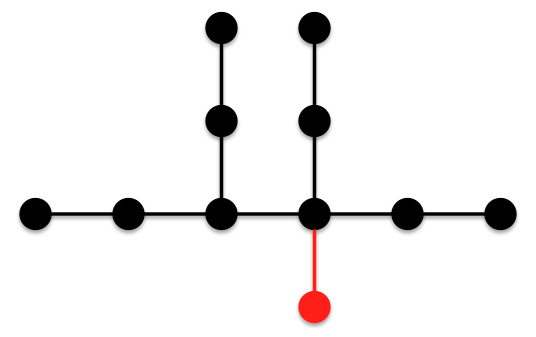 The original given by Furtula:Number of 2-1 edges:4Number of 2-2edges:1Number of 3-2edges:4Number of 3-3 edges:1The example above (Example A):Number of 2-1 edges:4Number of 2-2 edges:0Number of 3-2 edges:2Number of 3-3 edges:0Number of 3-4 edges:1Number of 4-1edges:1Number of 4-2 edges:2It seems that to go from the original given by Furtula to Example A the following transformations take place:
The original given by Furtula:Number of 2-1 edges:4Number of 2-2edges:1Number of 3-2edges:4Number of 3-3 edges:1The example above (Example A):Number of 2-1 edges:4Number of 2-2 edges:0Number of 3-2 edges:2Number of 3-3 edges:0Number of 3-4 edges:1Number of 4-1edges:1Number of 4-2 edges:2It seems that to go from the original given by Furtula to Example A the following transformations take place: so in terms of contributions there in no change to the ABC Index
so in terms of contributions there in no change to the ABC Index no change
no change no change
no change CHANGE:
CHANGE: 

 Since any edge with at least one terminal vertex of degree 2 will contribute
Since any edge with at least one terminal vertex of degree 2 will contribute  to the ABC index regardless of the degree of the other terminal vertex, no change occurs to the ABC index from the first three transformations. However, the last two transformations result in a greater contribution to the ABC index and thus Furtula’s tree with 11 vertices is still the minimal tree.Let us try another transformation (Example B):
to the ABC index regardless of the degree of the other terminal vertex, no change occurs to the ABC index from the first three transformations. However, the last two transformations result in a greater contribution to the ABC index and thus Furtula’s tree with 11 vertices is still the minimal tree.Let us try another transformation (Example B):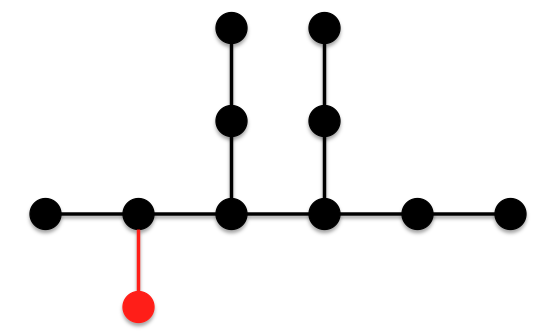 We have now lost two 2-1 edges and gained two 3-1 edgesWe have also lost a 3-2 edge for a 3-3 edge.Since the contribution of a 2-1 edge is less than the contribution of a 3-1 edge, this transformation increases the ABC index.However, as mentioned above, the 3-3 edge contributes less than the 3-2 edge so we must calculate the decrease in the ABC index and ensure that it is less than the increase caused by the first transformation.Contribution of a 2-1 edge:
We have now lost two 2-1 edges and gained two 3-1 edgesWe have also lost a 3-2 edge for a 3-3 edge.Since the contribution of a 2-1 edge is less than the contribution of a 3-1 edge, this transformation increases the ABC index.However, as mentioned above, the 3-3 edge contributes less than the 3-2 edge so we must calculate the decrease in the ABC index and ensure that it is less than the increase caused by the first transformation.Contribution of a 2-1 edge:  Contribution of a 3-1 edge:
Contribution of a 3-1 edge: Thus the total increase to the ABC index is:
Thus the total increase to the ABC index is:  Contribution of a 3-2 edge:
Contribution of a 3-2 edge:  Contribution of a 3-3 edge:
Contribution of a 3-3 edge:  Thus the total decrease to the ABC index is:
Thus the total decrease to the ABC index is:  Therefore, this transformation ultimately results in an increase in the ABC index and Furtula’s tree is still the minimal example.What about the following tree, call it example C?
Therefore, this transformation ultimately results in an increase in the ABC index and Furtula’s tree is still the minimal example.What about the following tree, call it example C?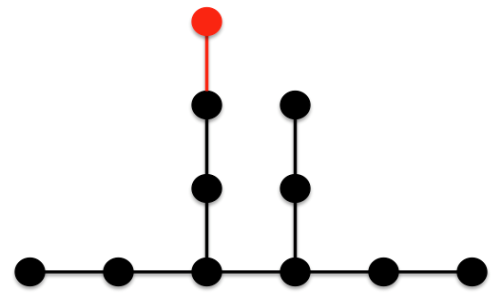 Here we see that there is no change to the ABC index from the transformation; however, this is not a new formation. In fact, this tree has the same ABC index as Furtula’s for the simple reason that it is isomorphic to Furtula’s tree.
Here we see that there is no change to the ABC index from the transformation; however, this is not a new formation. In fact, this tree has the same ABC index as Furtula’s for the simple reason that it is isomorphic to Furtula’s tree.5.2. Determining the Tree of Minimal ABC Index with 12 Vertices
- Let us try to construct a tree of minimal ABC index for
 Given what we now know about the contribution of certain edges, we would like to have as many 3-3, 3-4 and/or 4-4 edges as possibleTry starting with a vertex of degree 4
Given what we now know about the contribution of certain edges, we would like to have as many 3-3, 3-4 and/or 4-4 edges as possibleTry starting with a vertex of degree 4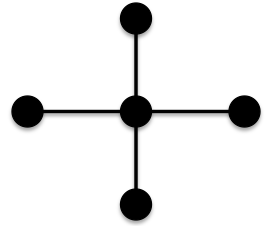 Now let us connect this tree with another tree to form a 4-4 edge.
Now let us connect this tree with another tree to form a 4-4 edge. 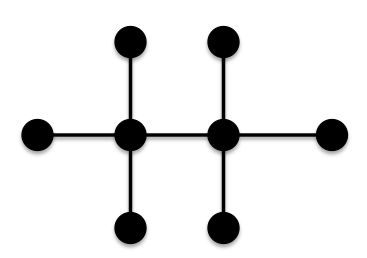 Here we have used 7 of the 12 vertices.We know that 4-1 edges contribute more than 4-2 edges so let us add a pendant edge to each of the pendant vertices to develop the following tree:This tree has 12 vertices but is this tree of minimal ABC index?
Here we have used 7 of the 12 vertices.We know that 4-1 edges contribute more than 4-2 edges so let us add a pendant edge to each of the pendant vertices to develop the following tree:This tree has 12 vertices but is this tree of minimal ABC index?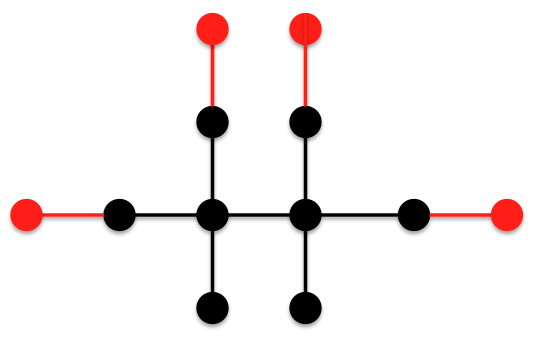 Note that this tree still has two 4-1 edges. The question is: does it make sense to take one of these 4-1 edges and add it to one of the pendant edges? This would change one of the vertices of degree 4 to degree 3 so instead of having a 4-4 edge and two 4-2 edges we would now have a 3-4 edge and two 3-2 edges. The 3-2 edges will contribute the same as the 4-2 edges so they are not interesting. The question becomes: does a 3-4 edge contribute less than a 4-4 edge?The answer is no. A 3-4 edge contributes slightly more than a 4-4 edge. So the following tree is not the minimal tree:
Note that this tree still has two 4-1 edges. The question is: does it make sense to take one of these 4-1 edges and add it to one of the pendant edges? This would change one of the vertices of degree 4 to degree 3 so instead of having a 4-4 edge and two 4-2 edges we would now have a 3-4 edge and two 3-2 edges. The 3-2 edges will contribute the same as the 4-2 edges so they are not interesting. The question becomes: does a 3-4 edge contribute less than a 4-4 edge?The answer is no. A 3-4 edge contributes slightly more than a 4-4 edge. So the following tree is not the minimal tree: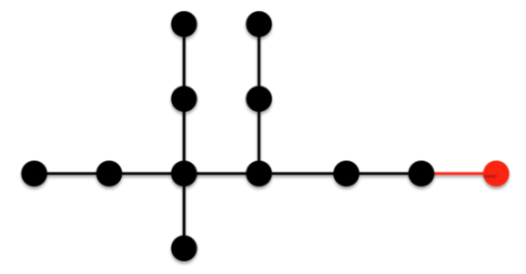 What if we take this edge and move it as follows so that we form another 4-2 edge instead of a 4-1 edge?:
What if we take this edge and move it as follows so that we form another 4-2 edge instead of a 4-1 edge?: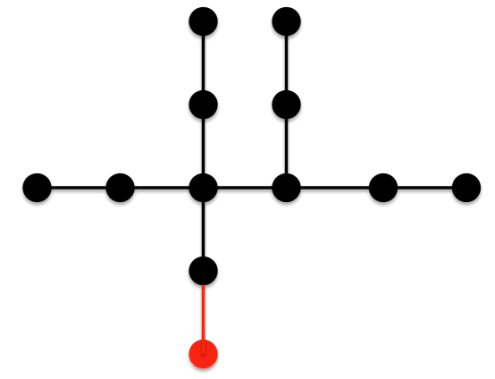 Now we have a slight increase in the ABC index because a 4-4 edge becomes a 3-4 edge but we also change a 4-1 edge to a 4-2 edge, which decreases the ABC index. Comparing the increase and decrease we see that the decrease is larger than the increase and thus this tree has a smaller ABC index than the previous trees.
Now we have a slight increase in the ABC index because a 4-4 edge becomes a 3-4 edge but we also change a 4-1 edge to a 4-2 edge, which decreases the ABC index. Comparing the increase and decrease we see that the decrease is larger than the increase and thus this tree has a smaller ABC index than the previous trees. Thus, we establish the tree of minimal ABC index with n=12 (Confirmed by Furtula)
Thus, we establish the tree of minimal ABC index with n=12 (Confirmed by Furtula) 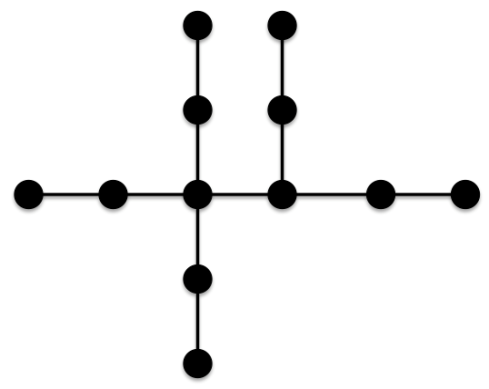
6. Class Γ and Graphs of Maximal ABC Index
- Another leader in chemical graph theory is Indian mathematician Kinkar Das who is currently employed in the Department of Mathematics in Sungkyunkwan University, Korea. His research interests include Spectral Graph Theory, Molecular Graph Theory, Algorithm and Complexity, General Graph Theory, Discrete Mathematics, Combinatorics, and Graph Labeling. He has also worked with Furtula to publish findings on the ABC Index. The following section is a brief description of the findings outlined by Das in his article: Atom-bond connectivity index of graphs published in 2010. Here, the discussion will center on a specific class
 of graphs described by Das and some results regarding graphs that are not chemical trees (such as those in class
of graphs described by Das and some results regarding graphs that are not chemical trees (such as those in class  ) will be introduced.
) will be introduced.6.1. The Class 
- Let us explore another class of graphs,
 postulated by Kinkar Das. Let H be a graph in
postulated by Kinkar Das. Let H be a graph in  and let
and let  be the number of edges in H. Then:1. H is a connected graph2. H has minimum vertex degree
be the number of edges in H. Then:1. H is a connected graph2. H has minimum vertex degree .3. H has q edges between vertices of maximum degree
.3. H has q edges between vertices of maximum degree  where
where  4. H has
4. H has  edges for which at least one of the terminal vertices has degree
edges for which at least one of the terminal vertices has degree  .And q is given by:
.And q is given by: Thus, an edge, say
Thus, an edge, say  , is of one of two possible types: either
, is of one of two possible types: either  has at least one terminal vertex of degree
has at least one terminal vertex of degree  or both the terminal vertices of h are of maximum degree
or both the terminal vertices of h are of maximum degree  [1].
[1].6.2. ABC Index of Graphs from Class 
- The characteristics of a graph H in Class
 imply that the contribution of an edge h to the ABC(H) is either
imply that the contribution of an edge h to the ABC(H) is either 
 Therefore, we deduce the following equation for the ABC(H):
Therefore, we deduce the following equation for the ABC(H):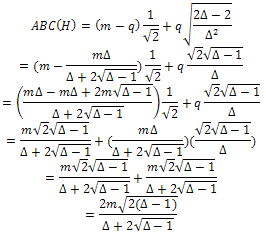 Therefore,
Therefore, Note that any graph T which is tree cannot be in
Note that any graph T which is tree cannot be in  for the simple reason that a tree has pendant vertices of degree 1 and thus the minimum vertex degree for any tree is
for the simple reason that a tree has pendant vertices of degree 1 and thus the minimum vertex degree for any tree is 
6.3. Examples
- Now let us examine some examples of graphs from class
 . As mentioned above, these graphs will not have any pendant edges. Let us start with the most basic cycle, K3.This graph, K3 is connected and it has minimum vertex degree
. As mentioned above, these graphs will not have any pendant edges. Let us start with the most basic cycle, K3.This graph, K3 is connected and it has minimum vertex degree  but
but  since it has maximum vertex degree
since it has maximum vertex degree 
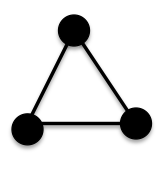 Is
Is  ?
?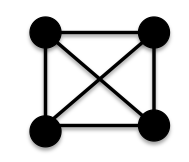 K4 is connected, has maximum vertex degree
K4 is connected, has maximum vertex degree  but now K4 has minimum vertex degree
but now K4 has minimum vertex degree  What happens if we remove one of the diagonal edges?
What happens if we remove one of the diagonal edges?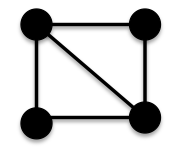 Call this graph A. A
Call this graph A. A  since A is connected, has
since A is connected, has  , has
, has  and all of its edges are either between vertices of maximum degree or between vertices with at least on vertex of degree 2.Let us try adding triangular shaped graphs onto some of the vertices to see if we can generate another example of a graph from the class
and all of its edges are either between vertices of maximum degree or between vertices with at least on vertex of degree 2.Let us try adding triangular shaped graphs onto some of the vertices to see if we can generate another example of a graph from the class 
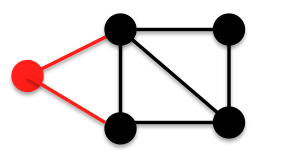 This graph, call it B, is not in
This graph, call it B, is not in  . It has
. It has  and it has a 4-3 edge. This edge is not between two vertices of maximum vertex degree, nor does it have at least one vertex of degree
and it has a 4-3 edge. This edge is not between two vertices of maximum vertex degree, nor does it have at least one vertex of degree 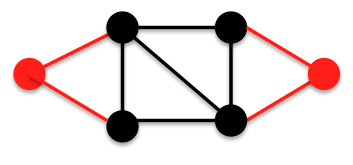
 Let us try to remedy this by adding a second triangular graph to the right side of the graph B as follows:We still have
Let us try to remedy this by adding a second triangular graph to the right side of the graph B as follows:We still have  and 4-3 edges.Let us try making the core a complete graph K4 by adding an edge as follows:
and 4-3 edges.Let us try making the core a complete graph K4 by adding an edge as follows: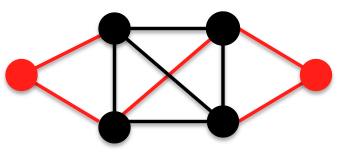 Now check that this graph, call it C, meets all the criteria in order for it to belong to
Now check that this graph, call it C, meets all the criteria in order for it to belong to  1. It is connected.2. It has minimum vertex degree
1. It is connected.2. It has minimum vertex degree  3. It has
3. It has  edge between vertices of maximum degree
edge between vertices of maximum degree  4. It has
4. It has  edges for which at least one of the terminal vertices is of degree
edges for which at least one of the terminal vertices is of degree  Thus,
Thus,  and we can now easily calculate its ABC index because we know that for all graphs
and we can now easily calculate its ABC index because we know that for all graphs  ,Consider the following graph D:
,Consider the following graph D:
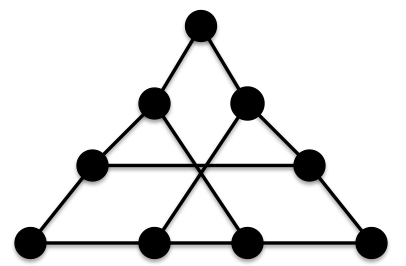
 since D is connected, D has
since D is connected, D has  D has
D has and all of the edges of D are either between two vertices of degree
and all of the edges of D are either between two vertices of degree  or have at least one vertex of degree
or have at least one vertex of degree 
 .
.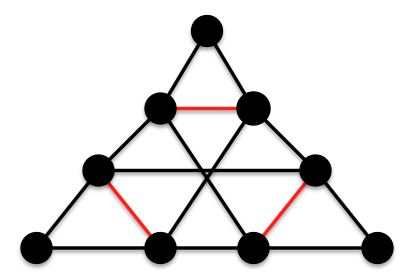 In fact, we can add 3 more edges to form a graph E with maximum degree
In fact, we can add 3 more edges to form a graph E with maximum degree  where
where 
 And, we can add 6 edges to turn the core of the graph E into K6 and generate a new graph F as follows:
And, we can add 6 edges to turn the core of the graph E into K6 and generate a new graph F as follows: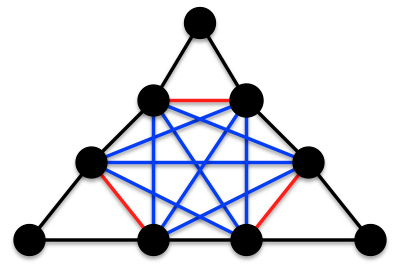
 Now we can add 3 triangles to graph F to form the following graph G that is also in
Now we can add 3 triangles to graph F to form the following graph G that is also in  In G,
In G, 

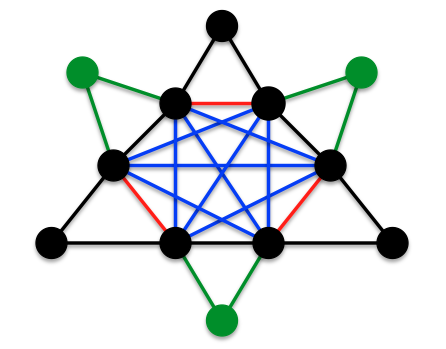
6.4. Alternative Formulation of the ABC Index
- Das states the ABC index equivalently as follows:
 This formulation allows for the taking into account of the modified second Zagreb index
This formulation allows for the taking into account of the modified second Zagreb index  which is equal to the sum of the products of the reciprocal of the degrees of pairs of adjacent vertices, that is,
which is equal to the sum of the products of the reciprocal of the degrees of pairs of adjacent vertices, that is, .This modified second Zagreb index is used by Das is the formulation of many theorems and their subsequent corollaries establishing upper and lower bounds on the ABC index of specific simple connected graphs with particular characteristics[1].
.This modified second Zagreb index is used by Das is the formulation of many theorems and their subsequent corollaries establishing upper and lower bounds on the ABC index of specific simple connected graphs with particular characteristics[1].6.5. Graphs of Maximal ABC Index
- It is generally accepted that the graph of maximal ABC Index with n vertices is, K1,n-1 commonly known as the star graph[5]. Brief reasoning behind this notion:
 For a pendant edge uv, with du=1 and dv=v,
For a pendant edge uv, with du=1 and dv=v, And obviously, to maximize this you would take the highest value for v possible, thus you need all the edges to be of the from
And obviously, to maximize this you would take the highest value for v possible, thus you need all the edges to be of the from  is the maximum vertex degree in the graph G.But why choose to have all pendant edges?Well, if we look at the original formulation of the ABC Index:
is the maximum vertex degree in the graph G.But why choose to have all pendant edges?Well, if we look at the original formulation of the ABC Index: Note that in order to maximize this equation we need to make du+dv-2 as large as possible while keeping dudv as small as possible. And, as it turns out, this is achieved by making one of the degrees 1 and the other
Note that in order to maximize this equation we need to make du+dv-2 as large as possible while keeping dudv as small as possible. And, as it turns out, this is achieved by making one of the degrees 1 and the other 
7. Conclusions
- The problem of determining the tree(s) that minimize(s) the ABC index for fixed number of vertices n is still open. It is difficult even when the maximum vertex degree is limited to 4, i.e. on chemical trees. Here we suggested an approach based on the contribution of certain edges. Conceivably, one can devise a procedure that identifies an edge to be replaced and place in the tree where it has to be reinserted in order to minimize the ABC index. Our work serves as a good source of heuristics on which edges should be considered candidates for replacement, as well as what structural components should be sought.
ACKNOWLEDGEMENTS
- Dr. Vassilev’s work is supported by NSERC Discovery Grant. Laura Huntington wants to acknowledge the help of Dr. Vassilev during the work on this paper. Both authors would like to acknowledge the friendly and collegial atmosphere at the 2nd Annual Workshop on Algorithmic Graph Theory held at Nipissing University on May 16-20, 2011. It is there where the idea for this research was conceived and informally discussed. We also acknowledge the correspondence of Dr. Darko Dimitorv, Freie Universität, Berlin, who helped us identify relevant literature on the problem.
 Abstract
Abstract Reference
Reference Full-Text PDF
Full-Text PDF Full-text HTML
Full-text HTML